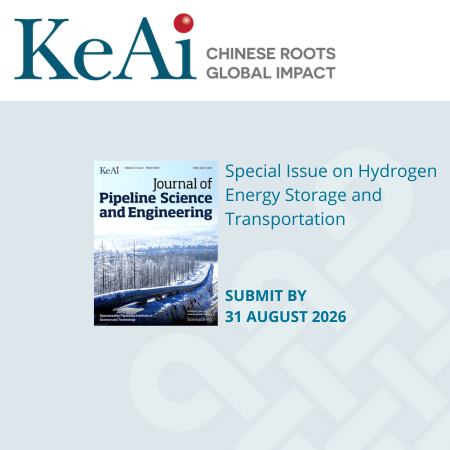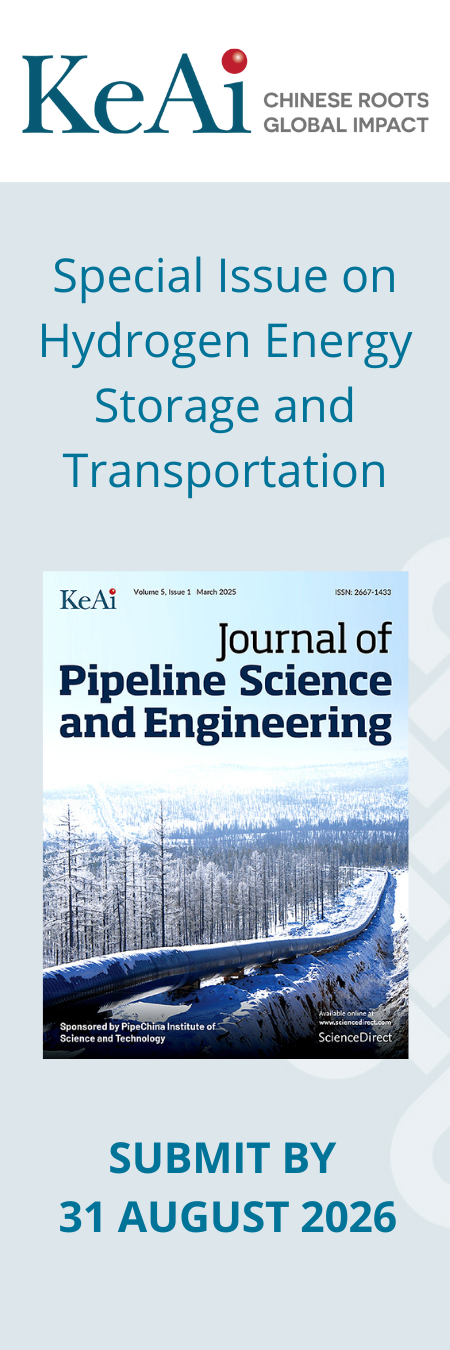Accelerate the development of a new energy system with “substance-energy network” as the foundation
December 2025
Combined ductile-brittle fracture simulation of API X80 under impact loading
December 2025
This study explores finite element (FE) simulation of the combined ductile-brittle fracture behavior of API X80 steel under impact loading, incorporating the influences of strain rate and adiabatic...
Effect of gas impurities on the dissociative adsorption of hydrogen on Fe(100) surface of pipeline steel
December 2025
As common impurities in natural gas and hydrogen compatibility experiments, oxygen (O2) and water (H2O) have a significant impact on hydrogen compatibility of pipeline materials. The competition among...
Development and simulation analysis of a novel flexible deformation inspection units (FDIU) for oil and gas pipelines
December 2025
Oil and gas pipelines are essential for energy transportation, and their integrity is critical for safety and efficiency. Deformations such as dents can lead to failures, necessitating regular condition...
An experimental investigation on the turbulent drag reduction effect of polyacrylamide solution in the loop pipe
December 2025
•The saturation concentration has been found and defined during polymer drag reduction in loop pipe.•A relationship among maximum drag reduction DRmax, Wi, polymer molecular weight and solution concentration...
A hybrid intelligent time-series framework for predicting short-term LNG sendout rate
December 2025
Accurate forecasting of the liquefied natural gas (LNG) sendout rate is essential for stabilizing downstream natural gas supply and shaving emergency peak effectively. However, the volatility of LNG...
Effect of phase change on corrosion behavior of X65 steel in CO2 transportation pipeline environment
December 2025
Phase change is inevitable in long-distance CO2 transport pipelines. In this study, an in-situ electrochemical noise monitoring device was constructed to study the effect of phase change on corrosion...
Burst pressure models and validations for thick-walled pipelines containing corrosion defects
December 2025
Corrosion is one major threat to pipeline integrity. Over the past decades, many corrosion models have been developed for determining the remaining strength of corroded pipelines, including ASME B31.G,...
Characterization of CTOA for resistance to pipeline ductile fracture propagation
December 2025
In the present paper, the crack-tip opening angle (CTOA) data used by Jiao et al. are assessed to show that the CTOA-fracture speed data were in transient regions of different types of drop-weight tear...
A review of cavitation problems of cryogenic fluids in gathering pipelines
December 2025
As the market share of clean energy such as liquefied natural gas (LNG) and liquid hydrogen gradually increases, cryogenic fluid transportation pipeline system applications are becoming more and more...
A reliability assessment method of high grade steel large diameter natural gas transmission pipelines considering defects correlation
December 2025
High grade steel large diameter natural gas pipelines play a pivotal role in natural gas long-distance transportation, yet their safety assessment confronts significant challenges from the coupling...
Evaluating the impact of integrating fourth industrial revolution (4IR) technologies in maintenance of pressure vessels and pipelines in the petrochemical industry
December 2025
This study evaluates the impact of integrating Fourth Industrial Revolution (4IR) technologies into maintenance management for pressure vessels and pipelines in the petrochemical industry. Using a Fuzzy...
Active control of natural gas pipeline system based on Box-Jenkins method
December 2025
•Developed a transient model for natural gas pipeline system.•Calibrated the model coefficients using operational data.•Established a state inversion control algorithm and a Linear Quadratic Regulator...
Advancements and future outlook of safety monitoring, inspection and assessment technologies for oil and gas pipeline networks
December 2025
The expansion of high-grade steel, large-diameter, and high-pressure pipelines, along with the integration of new energy and unconventional media into oil and gas pipeline networks, poses significant...
Standards and codes for hydrogen in pipeline infrastructure: testing, qualification, and integrity assessment
December 2025
•Framework with Gaps: Current standards provide foundational guidance for qualifying materials and infrastructure in hydrogen service but are insufficient for addressing the unique challenges of hydrogen...
AI-based approaches for predicting buried pipeline stability in cohesive-frictional soil under inclined forces: FELA, DNN, RNN, LSTM, and MARS
December 2025
This study explores the uplift resistance of buried pipelines in cohesive-frictional soils using finite element limit analysis (FELA) combined with artificial intelligence (AI) techniques, specifically...
VIP: A visual insulated pipeline dataset for computer vision tasks
Available online 17 December 2025
Although computer vision is being developed across several fields, no well-established dataset currently exists for visual insulated pipeline inspection. The lack of such a dataset negatively affects...
A Review of Research on Leakage and Diffusion Characteristics of Buried Gas Pipelines
Available online 17 December 2025
As natural gas consumption grows and transmission networks expand, leakage from buried pipelines has become a significant threat to public safety, ecosystems, and climate stability. In recent years,...
Pipeline network robustness analysis with complex network theory
Available online 15 December 2025
Oil and gas pipelines constitute the backbone of global energy transportation, serving as critical infrastructure that ensures the continuous supply of energy resources across vast geographical regions....
Natural Gas Supply Infrastructure Capacity and Security Sustainable Planning as Leader-Follower Model
Available online 11 December 2025
•Natural gas supply infrastructure is aging and needs sustainable restructuring•Leader-follower representation of natural gas suppliers is not common•Leader’s profit maximization is a major element...
A bibliometric review of hydrogen storage and transportation safety research
Available online 11 December 2025
Rising concerns over carbon emissions from fossil fuels have fueled interest in renewable energies. Hydrogen, as a clean energy source, stands out for its free of pollution and high calorific value....
Three-Dimensional Soil-Arching Model for Predicting Earth Pressure on Buried Pipelines under Localized Subsidence
Available online 11 December 2025
Localized foundation subsidence can lead to catastrophic failure of adjacent buried pipelines, severely compromising their serviceability. As a common cause of municipal pipeline damage, localized subsidence...
Methanol-Oil Co-transportation System: Strategic Facility Planning for Multiproduct Pipelines to Maximize Benefits
Available online 8 December 2025
Shifts in energy consumption patterns and the adoption of cleaner fuels have left multiproduct pipelines operating below their design capacity. Leveraging these existing multiproduct pipelines for methanol-oil...
Adaptive Pressure Wave for Blockage Localization via Variational Mode Decomposition and Time-Delay Correction
Available online 4 December 2025
Deep-sea oil and gas pipelines are prone to hydrate blockages under high-pressure and low-temperature conditions, posing significant threats to transportation safety and efficiency. Traditional acoustic...
Study of model adaptability and thermophysical property variations for ammonia and its mixtures
Available online 1 December 2025
•Model adaptability of ammonia and its mixtures’ thermal properties was evaluated.•Variations of thermophysical parameters for ammonia and its mixtures were analyzed.•Impurities significantly affect...


